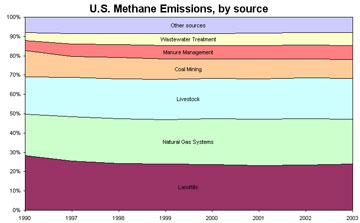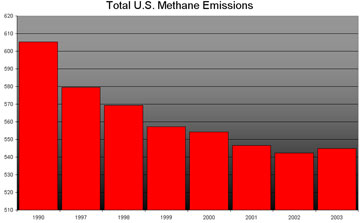Non-CO2 gases also cause global warming
Non-CO2 gases also cause global warming
mongabay.com
March 29, 2007
While most of the focus in developing a policy to fight global warming has been on carbon dioxide, other gases also contribute to climate change. The effect of these gases is still poorly understood and should be the subject of further research say two climate scientists writing in the March 30 issue of the journal Science.
“It is crucial that researchers continue to monitor non-CO2 greenhouse gas concentrations and investigate their sources, lifetimes, and spectroscopic properties. These data and insights will enable industry and policymakers to make informed decisions on the desirability and impact of allowing or curbing emissions,” write Keith P. Shine of the University of Reading and William T. Sturges of University of East Anglia.
“CO2 undoubtedly remains the single most important contributor to greenhouse gas radiative forcing, but the non-CO2 greenhouse gases are important both collectively and individually. It seems unlikely that we have overlooked a major contributor to radiative forcing, but this was probably what was thought in the early 1970s,” referring to the fact that the climate impact of methane was overlooked until that year.
 US Methane Emissions by Source, 1990-2003.  US Methane Emissions, 1990-2003. |
Shine and Sturges highlight methane, chlorofluorocarbons, and hydrofluorocarbons as greenhouse gases that may be disproportionately potent in warming the climate. They note that the heat “absorption strength of heavily fluorinated molecules can be 10,000 times that of CO2” while atmospheric concentrations of methane, which has more than 20 times the heating effect of CO2, have more than doubled since pre-industrial times.
Shine and Sturges suggest that the 1987 Montreal Protocol on Substances that Deplete the Ozone Layer, has helped slow the rate of global warming by restricting the use of ozone-depleting substances, chlorofluorocarbon, which simultaneously trap heat in the atmosphere. However they warn that the replacement of chlorofluorocarbons with hydrofluorocarbons is problematic because while hydrofluorocarbons are benign in terms of the impact on the ozone layer, they are strong greenhouse gases. Shine and Sturges note that the “concentration of the most abundant of these, HFC-134a, more than doubled every year in the mid-1990s and is still increasing by more than 10% per year; it is now at 40 ppt. The authors also mention fully fluorinated gases, including SF6 and perfluorocarbons such as CF4, as another distinct group of greenhouse gases that is poorly known but emissions of which are increasingly rapidly.
Related
Ozone ban has been more effective in fighting global warming than Kyoto Protocol. The 1987 Montreal Protocol, which restricted the use of ozone-depleting substances, has helped slow the rate of global warming in addition to protecting the ozone layer, report scientists writing in a paper published online in the early edition of PNAS. Signed in 1987, the Montreal Protocol on Substances that Deplete the Ozone Layer is an international treaty that limited production of ozone-depleting substances like chlorofluorocarbon compounds (CFCs) known as “freons” and bromofluorocarbon compounds known as Halons. These compounds are also known to be greenhouse gases dozens of times more potent than carbon dioxide.
Methane emissions rising, could worsen global warming. Concentrations of methane, a greenhouse gas more than twenty times more potent than carbon dioxide, are rising in Earth’s atmosphere finds a new study published in Nature.
CITATION: K.P. Shine and W.T. Sturges (2007). “The Non-CO2 Greenhouse Gases.” Science 315: 1804-1805